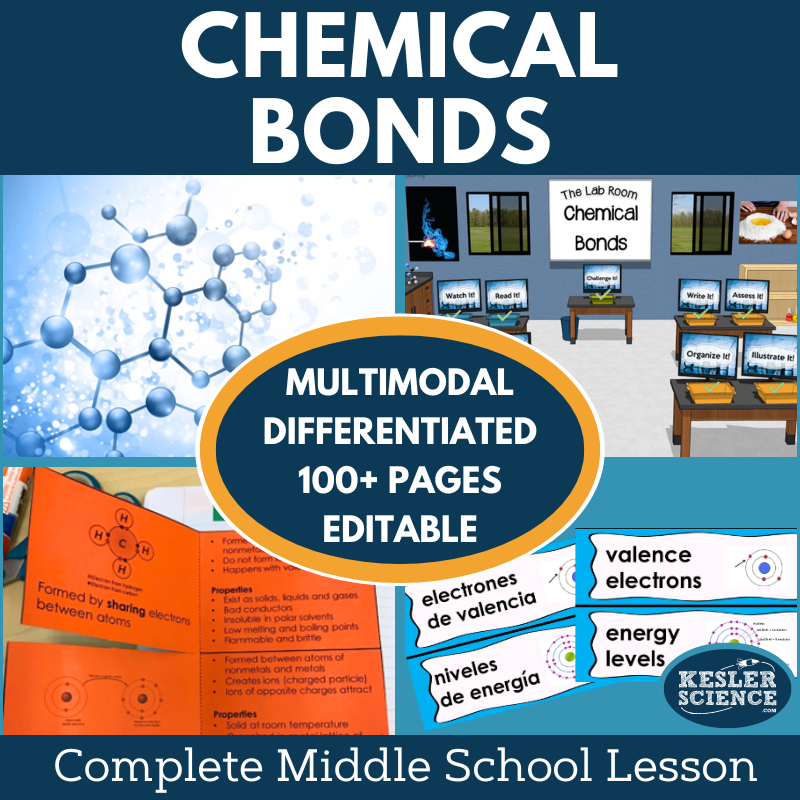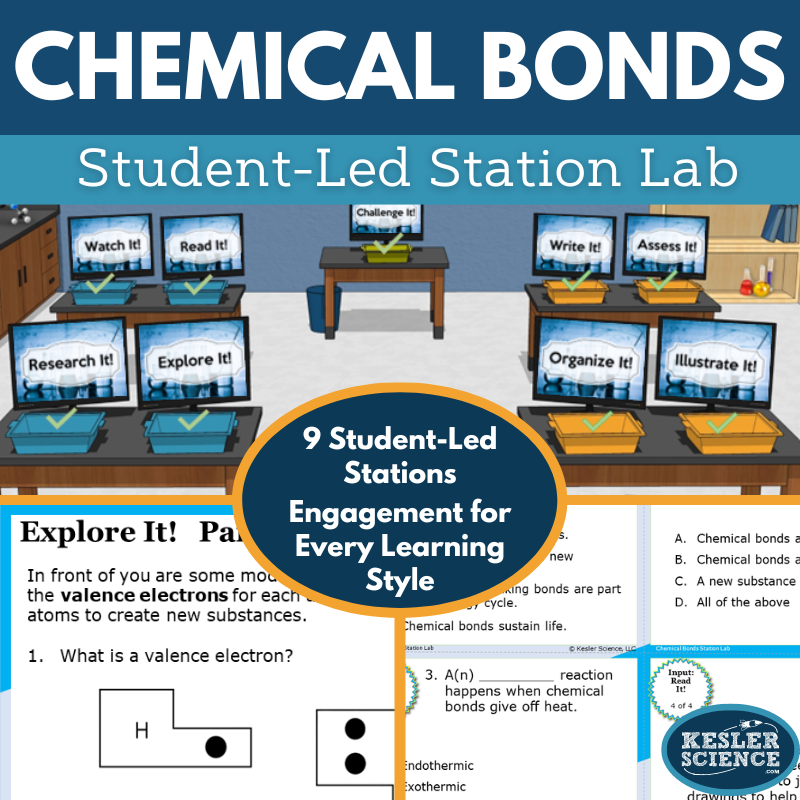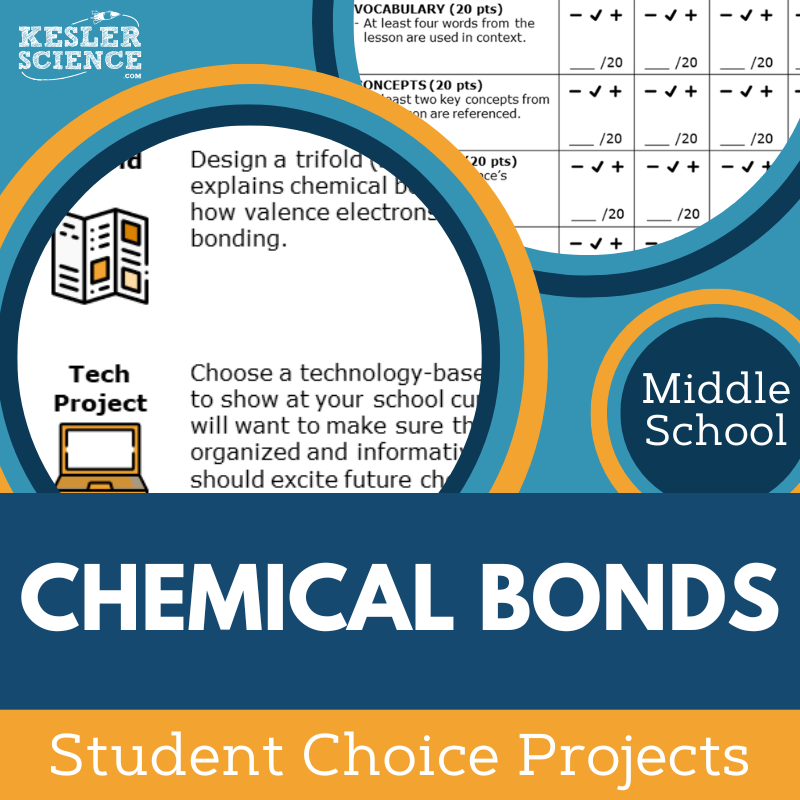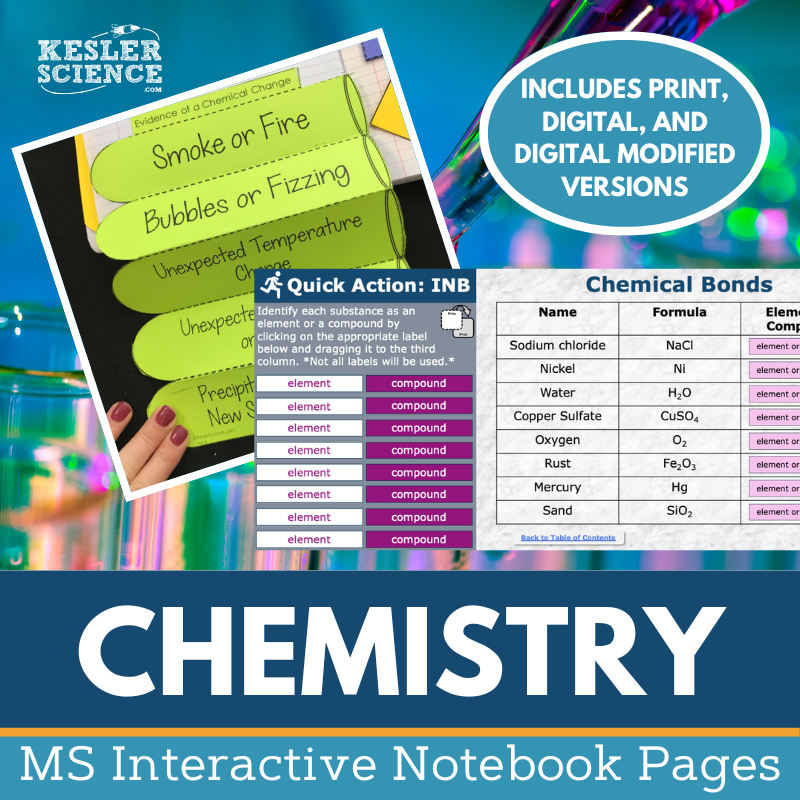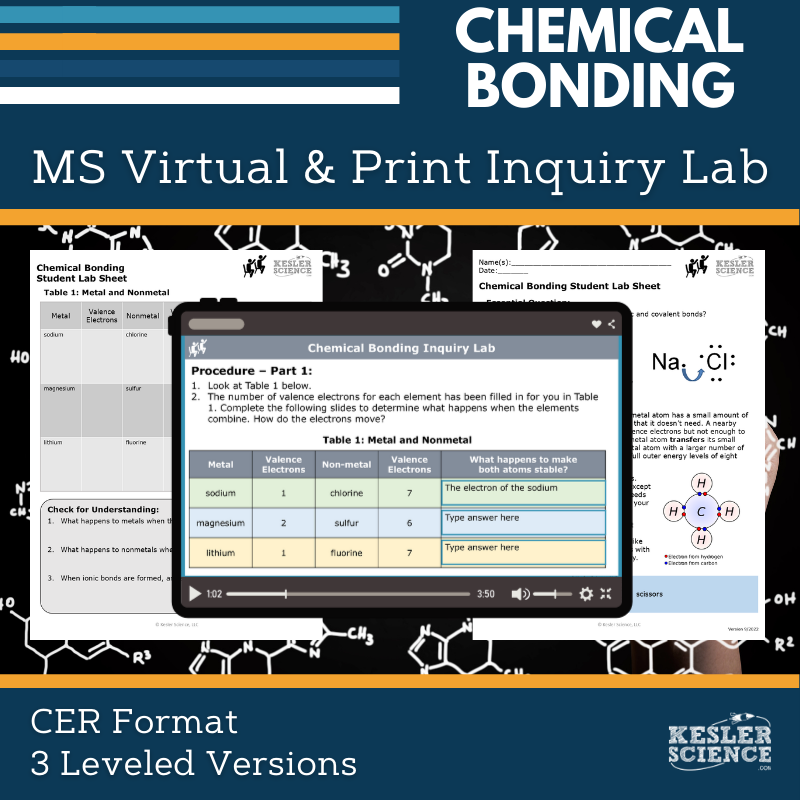Chemical Bonds Activities for Middle School Science
The Kesler Science Chemical Bonding resources offer a comprehensive, student-led curriculum designed for 6th to 8th grade students to explore ionic and covalent bonds. The resources below will give students a comprehensive understanding of chemical bonds. All of the following materials are also included in the Kesler Science Membership.
The Kesler Science Chemical Bonds Complete 5E Lesson provides all the materials needed for an engaging, multi-day lesson with minimal prep. This student-led learning experience enables middle school students to explore essential questions about chemical bonding, including why compounds bond, the role of valence electrons, and the differences between ionic and covalent bonding.
The lesson is structured around the 5E Model, offering differentiated activities and multimodal learning. Students work through various stations, such as hands-on demos, reading passages (with Spanish options), research tasks, and videos, to explore chemical bonds. Output stations allow students to organize, write, illustrate, and assess their understanding.
This resource is flexible and adaptable for both in-person and virtual learning. Editable PowerPoints, interactive notebook templates, and assessment options cater to diverse learning styles and provide opportunities for both classroom activities and home projects.
The Kesler Science Chemical Bonds Complete 5E Lesson provides all the materials needed for an engaging, multi-day lesson with minimal prep. This student-led learning experience enables middle school students to explore essential questions about chemical bonding, including why compounds bond, the role of valence electrons, and the differences between ionic and covalent bonding.
The lesson is structured around the 5E Model, offering differentiated activities and multimodal learning. Students work through various stations, such as hands-on demos, reading passages (with Spanish options), research tasks, and videos, to explore chemical bonds. Output stations allow students to organize, write, illustrate, and assess their understanding.
This resource is flexible and adaptable for both in-person and virtual learning. Editable PowerPoints, interactive notebook templates, and assessment options cater to diverse learning styles and provide opportunities for both classroom activities and home projects.
The Kesler Science Chemical Bonds Station Lab is a student-led, modular activity designed to engage middle school students in learning about chemical bonds. With eight differentiated stations and a ninth challenge station for early finishers, the lab allows students to personalize their learning experience, while the teacher facilitates rather than directs. The stations cover multiple learning modalities, offering hands-on activities, reading passages, research tasks, and videos.
Each station provides resources, task cards, and signage for independent or small group work. The stations explore key concepts such as analyzing data, interpreting substance properties, and applying knowledge of chemical bonds.
The station lab is adaptable for both in-person and virtual learning environments, with digital versions of activities available for tools like PowerPoint and Google Slides. The lesson encourages a deep understanding of chemical bonds while allowing students to demonstrate their learning through drawing, writing, organizing, and assessing tasks.
The Kesler Science Chemical Bonds Station Lab is a student-led, modular activity designed to engage middle school students in learning about chemical bonds. With eight differentiated stations and a ninth challenge station for early finishers, the lab allows students to personalize their learning experience, while the teacher facilitates rather than directs. The stations cover multiple learning modalities, offering hands-on activities, reading passages, research tasks, and videos.
Each station provides resources, task cards, and signage for independent or small group work. The stations explore key concepts such as analyzing data, interpreting substance properties, and applying knowledge of chemical bonds.
The station lab is adaptable for both in-person and virtual learning environments, with digital versions of activities available for tools like PowerPoint and Google Slides. The lesson encourages a deep understanding of chemical bonds while allowing students to demonstrate their learning through drawing, writing, organizing, and assessing tasks.
The Kesler Science Chemical Bonds Student Choice Projects offer middle school students a variety of project options that cater to different output styles. With nine project choices and the flexibility to "design your own," students can showcase their knowledge in creative ways. The lesson includes a grading rubric that allows for teacher, peer, or self-assessment, and teachers can modify it to suit their grading needs.
The projects are differentiated to support a wide range of learning needs, with a modified version offering additional support for students requiring remediation, while more challenging tasks are available for advanced learners. Teachers can also assign a combination of projects, ensuring flexibility for diverse classrooms.
The lesson is designed to be low-prep and uses common classroom supplies such as paper, markers, and scissors. Many projects are adaptable for digital completion, with some requiring basic crafting materials for hands-on models.
The Kesler Science Chemical Bonds Student Choice Projects offer middle school students a variety of project options that cater to different output styles. With nine project choices and the flexibility to "design your own," students can showcase their knowledge in creative ways. The lesson includes a grading rubric that allows for teacher, peer, or self-assessment, and teachers can modify it to suit their grading needs.
The projects are differentiated to support a wide range of learning needs, with a modified version offering additional support for students requiring remediation, while more challenging tasks are available for advanced learners. Teachers can also assign a combination of projects, ensuring flexibility for diverse classrooms.
The lesson is designed to be low-prep and uses common classroom supplies such as paper, markers, and scissors. Many projects are adaptable for digital completion, with some requiring basic crafting materials for hands-on models.
The Kesler Science Chemistry Interactive Notebook Bundle provides an engaging way for students to explore chemistry concepts through interactive activities. Designed for both traditional classrooms and digital learning environments, this bundle includes print and digital versions, making it versatile for in-person, 1:1, or distance learning settings.
Topics covered include acids and bases, atoms, balancing chemical equations, chemical bonds, physical and chemical changes, the periodic table, properties of water, and more. The digital version features a unique PowerPoint interactive notebook that can be uploaded to platforms like Google Slides, MS Teams, or Schoology. It includes reflection pages, note-taking space, a teacher answer key, and a modified version for students needing accommodations.
The paper version offers blank templates for student interaction, pre-filled options for modified learners or absentees, and visual examples for guidance. This resource is ideal for fostering hands-on and digital engagement in middle school chemistry.
The Kesler Science Chemistry Interactive Notebook Bundle provides an engaging way for students to explore chemistry concepts through interactive activities. Designed for both traditional classrooms and digital learning environments, this bundle includes print and digital versions, making it versatile for in-person, 1:1, or distance learning settings.
Topics covered include acids and bases, atoms, balancing chemical equations, chemical bonds, physical and chemical changes, the periodic table, properties of water, and more. The digital version features a unique PowerPoint interactive notebook that can be uploaded to platforms like Google Slides, MS Teams, or Schoology. It includes reflection pages, note-taking space, a teacher answer key, and a modified version for students needing accommodations.
The paper version offers blank templates for student interaction, pre-filled options for modified learners or absentees, and visual examples for guidance. This resource is ideal for fostering hands-on and digital engagement in middle school chemistry.
Looking for an interactive and flexible lab day? This engaging lesson allows students to explore ionic and covalent bonds using either a digital format or a hands-on printed version. Both versions include comprehension questions, Claim-Evidence-Reasoning (C.E.R.) prompts, and a reflection section to support deeper understanding. Whether your students are in person, remote, or absent, this lab ensures everyone can participate in meaningful learning.
In this activity, students use atom cards and beads to model the transfer and sharing of valence electrons in ionic and covalent bonds. The lab includes three differentiated versions—Modified, Dependent, and Independent—designed to meet a wide range of learners' needs. Students receive the right level of support while engaging with the essential question, "How are valence electrons involved in ionic and covalent bonds?"
The lab is fully editable and compatible with Google Slides and PowerPoint, making it easy to customize. It comes with detailed teacher guides, answer keys, and printable and digital formats at every difficulty level. Whether you're teaching advanced learners or providing scaffolds for those who need extra support, this lab makes prep quick and keeps students interested with multimodal learning options.
Looking for an interactive and flexible lab day? This engaging lesson allows students to explore ionic and covalent bonds using either a digital format or a hands-on printed version. Both versions include comprehension questions, Claim-Evidence-Reasoning (C.E.R.) prompts, and a reflection section to support deeper understanding. Whether your students are in person, remote, or absent, this lab ensures everyone can participate in meaningful learning.
In this activity, students use atom cards and beads to model the transfer and sharing of valence electrons in ionic and covalent bonds. The lab includes three differentiated versions—Modified, Dependent, and Independent—designed to meet a wide range of learners' needs. Students receive the right level of support while engaging with the essential question, "How are valence electrons involved in ionic and covalent bonds?"
The lab is fully editable and compatible with Google Slides and PowerPoint, making it easy to customize. It comes with detailed teacher guides, answer keys, and printable and digital formats at every difficulty level. Whether you're teaching advanced learners or providing scaffolds for those who need extra support, this lab makes prep quick and keeps students interested with multimodal learning options.
Year-Round Resources
These year-round activities will increase your students' understanding of many middle school science topics. All of these activities are also included in the Kesler Science Membership.
Visual Data & Graphing
You're not alone if your students struggle with understanding graphs, charts, and tables. It's a skill that takes an enormous amount of practice. This resource will help students build a strong foundation in analyzing data and creating their own data visualizations.
Bell Ringers and Warm-Ups
These middle school science bell ringers are an excellent way to engage your students as soon as they walk into your classroom. This comprehensive FULL YEAR resource includes everything you need to start off each science class with an interesting warm-up activity.
Review Board Games
Each game board has been carefully designed to keep students engaged. There are 10 different action spaces on each board and dozens of question cards. All of the actions are related to science concepts and keep the students motivated throughout the game.
Each game is ready to play. Simply print out the board and the cards and let the students enjoy reviewing nine different units.
Essential Questions
Below are the essential questions associated with the lessons and activities included in this unit. This topic is only one of more than 100 middle school science topics included in the Kesler Science Membership.
-
Why do compounds bond?
-
How are valence electrons related to chemical bonds?
-
What is covalent bonding?
-
What is ionic bonding?
Kesler Science Membership
Imagine never having to search for another middle school science lesson again. The membership gives you access to ALL of the Kesler Science products in one place (Yes, including everything above).
Say goodbye to long hours of lesson prep.

